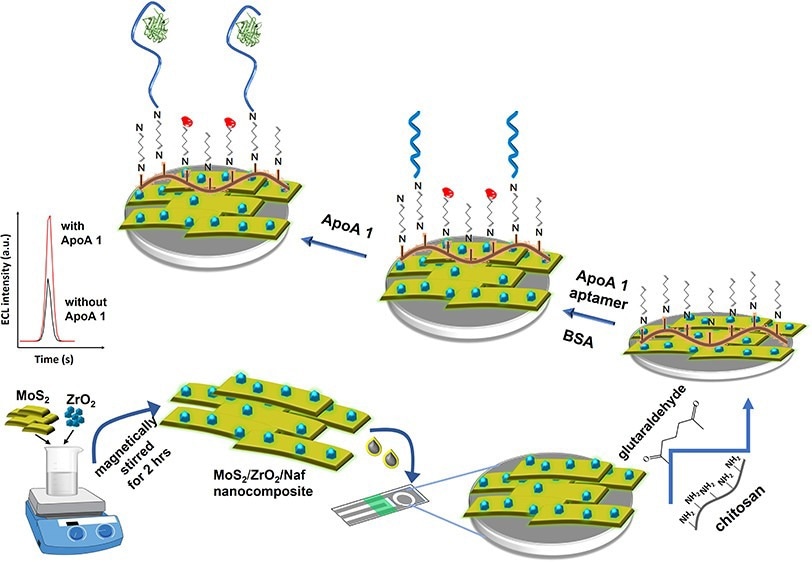An aptasensor is a class of biosensors in which the biological recognition element is a DNA or RNA aptamer. In an aptasensor, the aptamer recognizes the molecular target against which it was previously selected in vitro.

Study: Label-Free Electrochemiluminescence Nano-aptasensor for the Ultrasensitive Detection of ApoA1 in Human Serum. Image Credit: Kurup, C.P., Mohd-Naim, N.F., Keasberry, N.A., Zakaria, S.N.A., Bansal, V., Ahmed, M.U (2022) ACS Omega
An article published in ACS Omega presented an electrochemiluminescence (ECL) aptasensor based on molybdenum sulfide/zirconium oxide/Nafion (MoS2/ZrO2/Naf) nanocomposite for the ultrasensitive and selective detection of human apolipoprotein A-I (ApoA1), using the luminophore, tris(bipyridine) ruthenium (II) (Ru(bpy)32+).
The nanocomposite layer modified with chitosan (CS) facilitated glutaraldehyde (GLUT) crosslinking, which helped immobilize ApoA1 aptamers. In addition, various analytical techniques have been used to characterize nanocomposites. On the other hand, ECL, electrochemical impedance spectroscopy, and cyclic voltammetry helped analyze the aptasensor assembly.
Nanocomposites as electrode modifiers increased the intensity of the ECL signal. The interaction of the sensor surface with the ApoA1 biomarker produced an anionic environment that promoted the attachment of the aptamer-ApoA1 complex to Ru(bpy)32+, thereby enhancing the ECL signal.
ECL aptasensor demonstrated excellent sensitivity for ApoA1 with a detection limit (LOD) of 53 femtograms per milliliter and a dynamic range between 0.1 and 100 picograms per milliliter. The practical application of the proposed aptasensor was demonstrated by measuring ApoA1 levels in human serum samples, with 94-108% recovery rates.
Aptasensors and ApoA1 Protein
Aptamers are artificial nucleic acid (DNA or RNA) ligands that can be selected from combinatorial libraries of synthetic nucleic acids possessing specific binding characteristics to their targets.
Biosensors that employ aptamers as recognition elements are known as aptasensors. The development of aptasensors has been carried out with different detection schemes from label-free methods, such as surface plasmon resonance (SPR) and quartz crystal microbalance (QCM) measurements which have been reported to enhance the advancement of this field.
ECL is an ultrasensitive technique that combines chemiluminescence and electrochemical analysis. Because there is no excitation light source, ECL is more resistant to dispersed light interference and autofluorescence background noise than photoluminescence. Furthermore, the precise and reproducible potential of ECL initiates and regulates the ECL signals.
Consequently, ECL sensors provide trustworthy sensing systems with sensing functionality. Luminol and its derivatives, Ru complexes, and quantum dots are examples of ECL reagents used in biosensors. Tipropylamine (TPA) as a co-reactant and Ru(bpy)32+ as a label are frequently used due to their high photon output and stability.
ApoA1 is a highly accurate marker of coronary heart disease. ApoA1 is a high-density lipoprotein (HDL) protein involved in reverse cholesterol transport, lipoprotein metabolism, and atherosclerosis prevention. Therefore, the development of accurate detection technologies for ApoA1 is crucial for the early detection and treatment of related disorders.
Nano-Aptasensor for the Ultrasensitive Detection of ApoA1
In the present study, a novel and facile ECL aptasensor based on MoS2/ZrO2/Naf was developed for the selective detection of ApoA1 with high sensitivity. A screen-printed carbon electrode (SPCE) was used as the working electrode, the surface was modified with a MoS2/ZrO2/Naf nanocomposite and compactly fixed with CS.
Modifying the electrode surface with the MoS2/ZrO2/Naf nanocomposite provided a large electroactive surface area and facilitated electron transport, thereby improving the electrochemical activity for biosensing. As a result, the MoS2/ZrO2/Naf-modified SPCE exhibited a 150% higher electroactive surface area than its unmodified counterpart.
Furthermore, utilizing GLUT as a crosslinking agent helped couple the ApoA1 aptamers with the modified electrode surface, resulting in the fabrication of an SPCE/ MoS2/ZrO2/Naf/CS/GLUT/Apt-modified sensor.
Finally, the ECL signal was generated by incubating the prepared aptasensor in a phosphate buffer saline (PBS) solution with potassium chloride (KCl), 50 micromolar Ru(bpy)32+, and 5 millimolar TPA. An improved ECL signal was obtained by forming an aptamer-ApoA1 complex, where the aptasensor offered ECL intensity-based ApoA1 detection with ultrasensitivity.
Conclusion
Overall, a MoS2/ZrO2/Naf nanocomposite-based ECL aptasensor was constructed to detect ApoA1. The surface area and electrochemical activity of the nanocomposite increased because of its superior physical and chemical characteristics.
When incubated with Ru(bpy)32+ in the presence of TPA, the nanocomposite displayed a significant ECL intensity. The CS on the surface of the modified electrode aided the attachment of the crosslinking agent GLUT. As a result, more ApoA1 aptamers with amine terminal groups were covalently immobilized, considerably enhancing detection sensitivity.
The ECL platform responded linearly to ApoA1 doses ranging between 0.1 and 1000 picogram per milliliter, with a LOD of 53 femtograms per milliliter. Due to the aptamer's unique recognition and capture capacity for ApoA1, it demonstrated high specificity for the target ApoA1 protein in the presence of diverse interfering proteins. The developed ECL aptasensor demonstrated high stability and repeatability as well as the detection of ApoA1 in human serum samples.
Reference
Kurup, C.P., Mohd-Naim, N.F., Keasberry, N.A., Zakaria, S.N.A., Bansal, V., Ahmed, M.U. (2022) Label-Free Electrochemiluminescence Nano-aptasensor for the Ultrasensitive Detection of ApoA1 in Human Serum. ACS Omega. https://doi.org/10.1021/acsomega.2c04300
Disclaimer: The views expressed here are those of the author expressed in their private capacity and do not necessarily represent the views of AZoM.com Limited T/A AZoNetwork the owner and operator of this website. This disclaimer forms part of the Terms and conditions of use of this website.